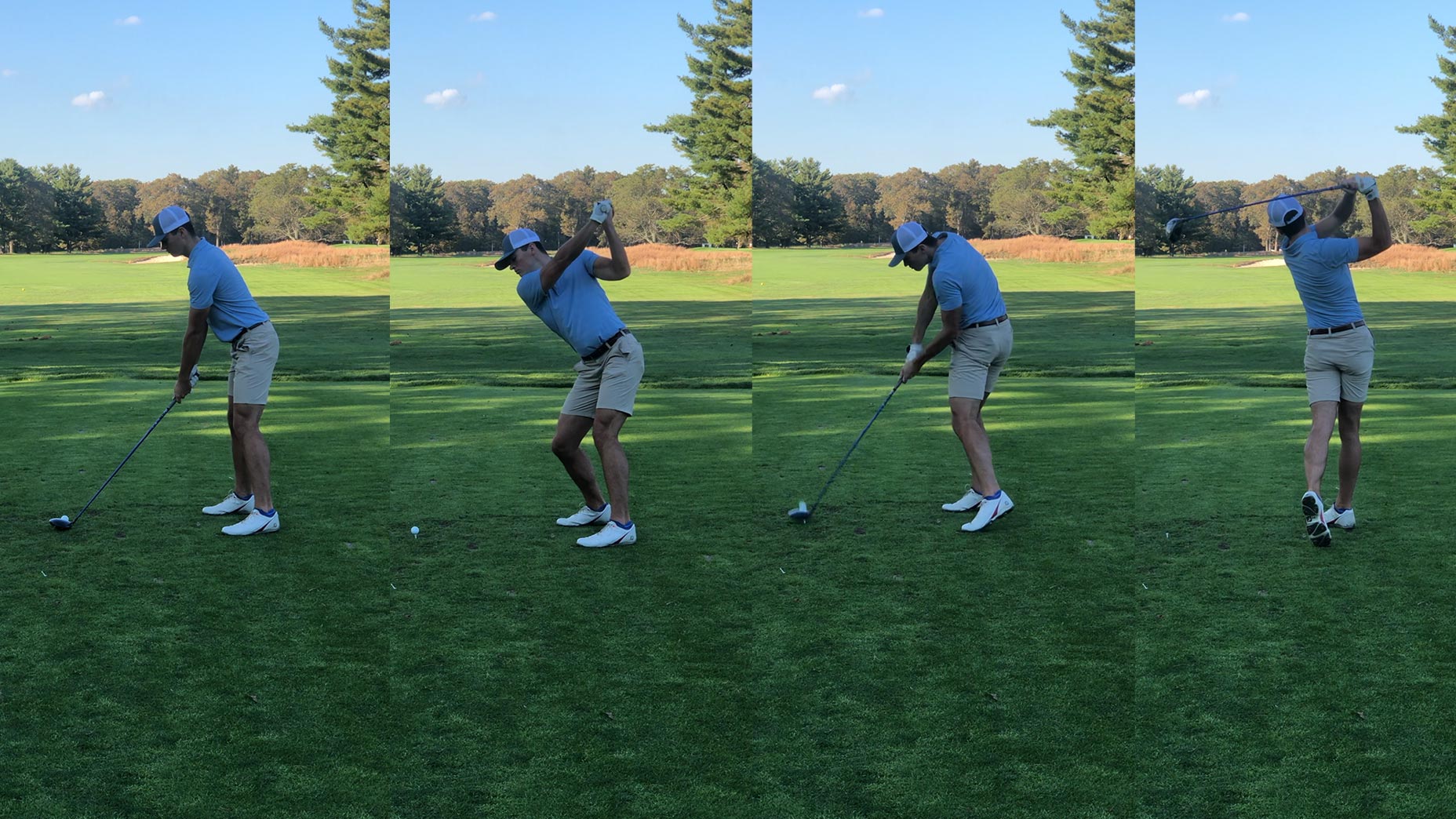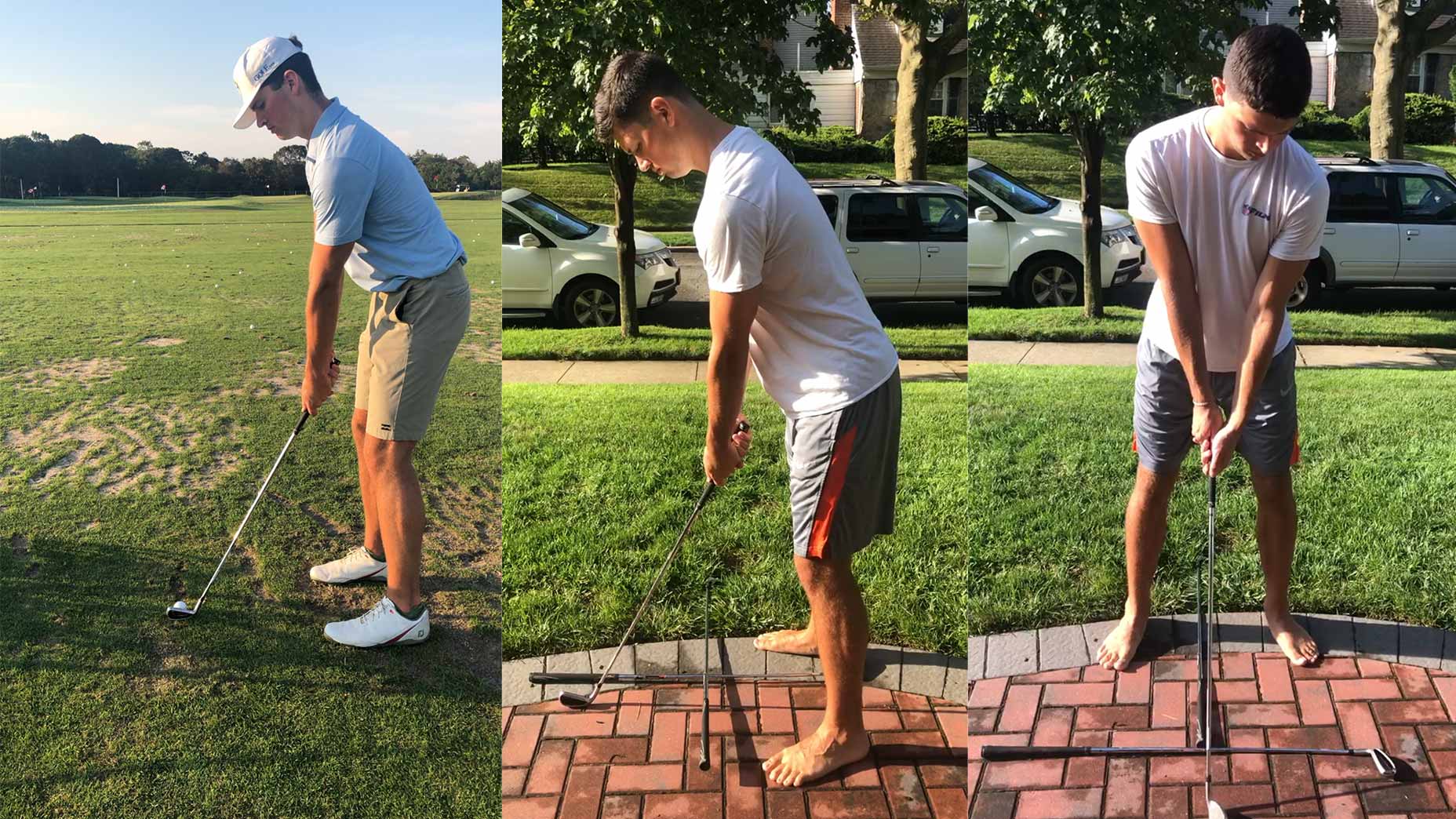Welcome to the 30-Day Challenge sponsored by Medterra, where one GOLF.com staffer leaves no stone unturned in the pursuit of a simple goal — breaking 90 — with the hopes of helping you do the same. This is the sixth in a seven-part series detailing his no-holds-barred journey to the 80s — all in just one month. You can read part 1 about the program he’s using to get better here, part 2 (a swing fix from his front lawn) here, part 3 on his game-changing club-fitting here, part 4 on the drill that turned the tide here, and part 5 on how he found a way to improve while on vacation here.
We reached the final week of GOLF’s 30-Day Challenge with more than a hint of skepticism. With only seven days left, my ability to deliver on my end of the bargain — my first-ever score in the 80s — came into serious question.
With the help of my Skillest virtual swing instructor Steve Giuliano, I’d made some serious changes to my setup, swing, and consistency. But when it came time to get out on the course, I hit a wall. My scores (which rotated between the mid-90s and low-100s) were poor enough to cast doubt on whether I’d seen any meaningful improvement to my game.
I felt like…well actually, that was the problem. I didn’t feel anything. Feel, that ephemeral comfort with the mechanics of one’s swing, had temporarily (or perhaps permanently) left me. Loss of feel over a golf club manifests itself in many ways, but in its purest form is a complete inability to predict anything about the outcome of each shot. A pitching wedge might travel 145 yards or 14, a 6-iron might fly straight through the air or curve heavily, left or right. The problem is not the outcome, it’s the inability to understand how you reached it.
How a club-fitting saved my golf game (and how it might save yours): 30-Day ChallengeBy: James Colgan
I told myself this was normal, to be expected from a golfer undergoing a swing overhaul for the first time in his adult life. But I’d also agreed to undergo GOLF’s 30-Day Challenge with the expectation that I wouldn’t embarrass myself. If I ended it without sniffing the 80s, it’d constitute pretty major (and very public) disappointment in my abilities as a golfer.
With desperation kicking in just a week left before the challenge ended, I had an idea. The key wasn’t to work harder (my calloused hands indicated I’d probably spent enough time at the range); it was to work smarter. If I couldn’t feel my way to bogeys and pars, I’d have to battle my way there. And if I was going to battle into the 80s, I needed a blueprint.
Below is my gameplan to break into the 80s in 10 tricks. While it might not give Bill Belichick a run for his money, it’s a simple, repeatable process every golfer can strive to reach, irrespective of your ability. It helped me while I re-felt my feel, and I am certain that it can help you, too.





Explore Medterra CBD Products
10 tricks for breaking 90
1. A warm-up is non-negotiable: If you don’t warm up properly, you’re guaranteed to hand away strokes over your first three holes as your body gets warm. And if you’re trying to climb out of the 90s, it’s critically important to take advantage of strokes wherever you can save them. Take 20 minutes before your tee time to hit a few balls on the range and roll a few putts. It’s not a lot, but it’s a significant mental and physical boost. Plus, you’ll get a better sense of which way the ball wants to fly that day.
2. Have 2 or fewer blowups off the tee, per round: For bad golfers, mistakes are inevitable. So finding a score under 90 isn’t an exercise in birdies and pars (though those certainly help), it’s about limiting the truly bad holes. The easiest way to avoid blowups is by keeping things in play off the tee. Don’t focus on finding fairways — focus on finding a comfortable swing that allows you to make consistent contact with the ball. If you can keep it to two or fewer holes in which you wind up OB or less than 100 yards off the tee, you’ll find it hard for your score to get away from you quickly.
3. Forget par: The biggest advice any 90s shooter can learn is to forget about the value of par. Too often, our attempts to “save par” turn into hero shots with little chance of success and wind up compounding our score. It’s simple math. On a par-70 course, you can break 90 simply by playing bogey golf.
3 ways to keep your game sharp while on vacationBy: James Colgan
Focus instead on continuously giving yourself chances to make bogey. Hit layups if you have to. Play irons off the tee. Aim for the large part of the green on par-3s. If you can keep the ball in front of you, an ultra-conservative approach to course management will give you a strong chance to break 90. Embrace it, even if it means gunning for fewer flags than you’re used to.
4. Two putts, zero problems: At the beginning of the round, your goal should be to make 18 two-putts. That’s not to say you should be lag-putting short birdie tries, but don’t become possessed by the strategy of “never leave a putt short!” either. I’d rather leave a putt six inches short than give myself six feet coming back the other way, and so would just about every PGA Tour player. Three-putts are an easy way to watch your scorecard implode, and they’re much easier to avoid with the proper mindset.
5. Know your swing thought(s): Everybody should have one swing thought (and no more than two!) before every shot Whether you’re focusing on breathing, posture, hand position, shoulder position or head position, there’s no “wrong” answer for what to think about — but having that focus adds some intentionality to your swing, which is a good thing.
6. Use the people around you: Need help with a read? Unsure of the line off the tee? The people around you are assets. Use them. Talk to them. Consult them. Golf is an incredibly lonely sport, the least you can do is hear what they have to say. Just remember that you don’t have to take every single bit of advice you hear, either.
7. Win from 100 yards and in: Short game truly is everything in golf. If you manage to keep yourself to one non-putting stroke from 100 yards and in on every hole, you’ll watch your score plummet. Of course, as someone who’s chunked and bladed more than his fair share of chips, I realize this is easier said than done. Which is why it’s so important to…
8. Give your wedges some love: As tempting as it is to stripe your driver off the back fence at the range, take time to practice making solid contact with your wedges. If you’re struggling with feel (like I was) the best way to quickly win back confidence is with those 10-50 yard chip shots and making sure you get them on the green every time.
9. Practice recovery shots: Yet another course management trick to minimize your mistakes. Every golfer hits bad shots, but not every golfer practices the strategies that can lead them back to safety. Practice hitting a few punches and bump-and-runs with your irons, and pay close attention to the trajectory, direction and distance each shot travels. No need to spend hours working on this, but a few shots can make a major difference between a blow-up hole and a scrambling par or bogey.
10. Practice recovery, period: Make no mistake about it, recovery is a huge pillar in your on-course success as a golfer. Make sure to take care of your joints and back. For me, that meant regular treatments using CBD pain products. But for you, that could mean anything from preventative treatment to ensuring you get the proper amount of sleep each night. Playing focused, pain-free golf is an incredibly underrated benefit in pursuit of that sub-90 score.







